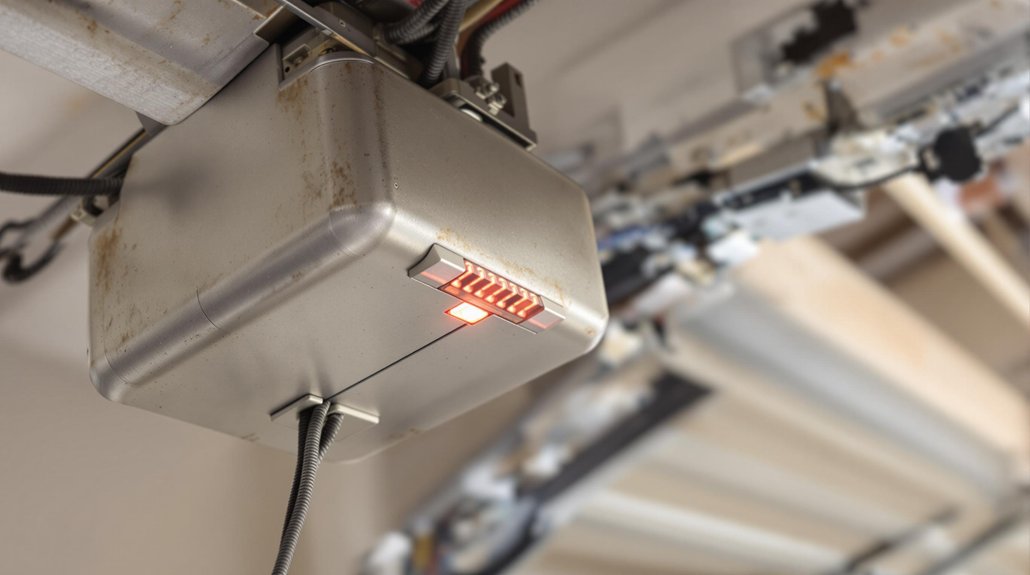To determine if a garage door motor is bad, watch for key signs. Unusual noises like grinding, squeaking, or banging can indicate serious issues. Inconsistent door movement, such as abrupt stops or slow openings, also signals trouble. If the door won't open or close at all, the motor might be silent, suggesting power problems. Remote control issues, visible signs of wear, or an aging motor can further confirm it's time for a check. Paying attention to these symptoms can guarantee safety. There is more to understand about maintaining your garage door for peak function.
Key Article Highlights
- Listen for unusual noises like grinding or banging, which may indicate damaged gears or loose parts in the motor.
- Check for inconsistent door movement such as irregular speeds or abrupt stops, suggesting motor calibration or component wear issues.
- A silent motor or an unresponsive wall switch often signals serious problems, including power supply failure or loose wiring.
- Inspect for visible wear and tear, like rust or corrosion, which can impact motor performance and longevity.
- If the motor is approaching 10-15 years of age and shows declining performance, consider replacement for safety and functionality.
Unusual Noises From the Motor
When listening to your garage door motor, unusual noises can be a clear sign of trouble. Sounds such as grinding, squeaking, or rattling may indicate that your motor needs attention. These noises often arise from worn-out parts or insufficient lubrication. Regular motor maintenance is essential to prevent these issues.
If you hear a grinding noise, it could mean that the gears are damaged or misaligned. Squeaking sounds often suggest that the rollers or tracks require lubrication. Rattling may point to loose hardware or components that are not securely fastened. Identifying these noises early can save you from more extensive repairs.
To achieve noise reduction, consider performing routine checks on your garage door system. Lubricate moving parts, tighten bolts, and inspect the motor regularly. Keeping the system clean and well-maintained not only reduces noise but also enhances the overall performance of the motor.
Inconsistent Door Movement
Unusual noises from the garage door motor can often indicate underlying issues, but another common problem is inconsistent door movement. When your garage door opens or closes at varying speeds, it may signal that the motor is not properly calibrated. This inconsistency can be frustrating and may affect the overall functionality of the garage door.
To understand the signs of inconsistent door movement, consider the following table:
| Symptoms | Possible Causes |
|---|---|
| Irregular opening speed | Motor calibration issues |
| Abrupt stops during motion | Worn out motor components |
| Delayed closing | Sensor misalignment |
| Unsteady movement | Power supply fluctuations |
When the door speed fluctuates, it can lead to safety hazards and increased wear on the motor. Proper motor calibration is essential to guarantee that the garage door operates smoothly. Regular checks and maintenance can keep the motor in good shape and help avoid these issues. If you notice inconsistent door movement, addressing it promptly can prevent further damage and guarantee a safe, reliable operation.
Door Won't Open or Close
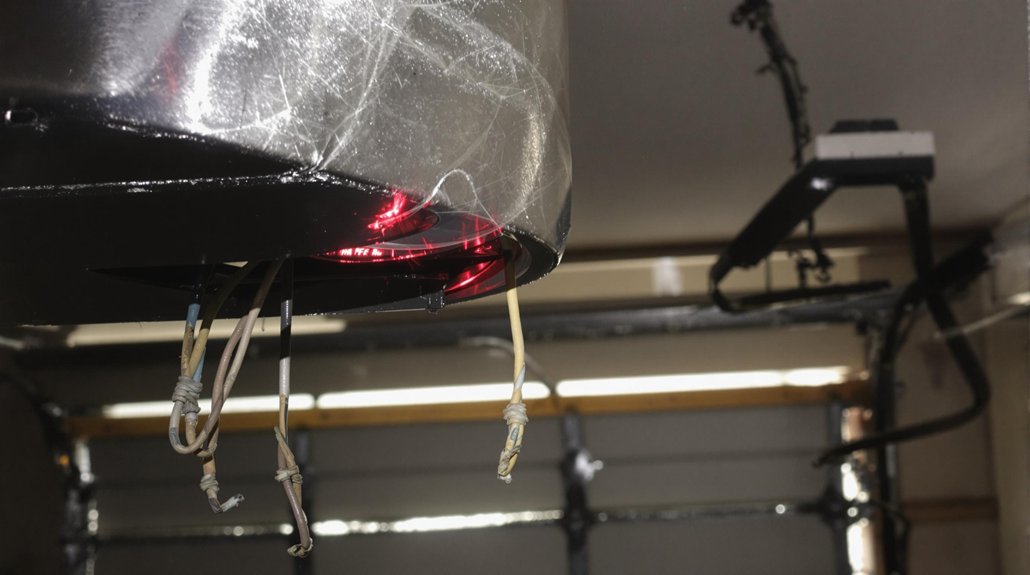
When a garage door won't open or close, it can be frustrating. One sign of a bad motor is when it makes no noise at all when you try to operate it. Additionally, if the wall switch is unresponsive, it could indicate a problem with the motor.
Motor Makes No Noise
A silent garage door can be a frustrating experience, especially when it refuses to open or close. If you find that the motor makes no noise at all, this could indicate a serious issue. The first step is to perform motor testing. Check if the motor unit is plugged in and if the circuit breaker is functioning properly.
Here are some common reasons for a silent motor:
| Possible Issues | Solutions |
|---|---|
| Power Supply Failure | Check power connection |
| Motor Malfunction | Call a technician |
| Remote Control Issues | Replace battery |
Before calling for help, consider some maintenance tips. Regularly inspect the garage door system, including the motor, for wear and tear. Lubricate moving parts to guarantee smooth operation. If the motor still does not respond, it may require replacement.
Unresponsive Wall Switch
Many homeowners rely on the wall switch to control their garage door, and an unresponsive switch can be a major inconvenience. When the door won't open or close, it is important to perform wall switch troubleshooting. Start by checking if the switch is connected properly. Loose wires can cause the switch to fail. Confirm that the circuit breaker is not tripped. A tripped breaker can stop power to the wall switch and the garage door motor.
Next, inspect the switch itself for damage. If the switch appears cracked or broken, it may need replacement. Additionally, test the switch by connecting it to a different power source, if possible. This will help determine if the switch is indeed the problem.
Garage door safety is also significant. If you notice any unusual behavior, like the door moving erratically, stop using the wall switch immediately. It could pose a safety risk. To summarize, an unresponsive wall switch can often indicate a simple issue, but it is essential to troubleshoot properly to guarantee safe operation of your garage door and to maintain functionality.
Remote Control Issues
Remote control issues can often signal problems with the garage door motor. When your remote fails to open or close the door, it is crucial to investigate. One common cause is remote battery issues. If the battery in your remote is low or dead, it will not send a strong signal to the motor. Replacing the battery is a simple first step to troubleshoot the problem.
Another factor to take into account is signal interference. This can occur when other electronic devices block the signal between the remote and the garage door motor. Items like wireless routers or even nearby vehicles can cause disruptions. If you suspect interference, try using the remote in a different location or at a different time of day to see if it works better.
If replacing the battery and checking for interference does not resolve the issue, the problem may lie within the garage door motor itself. Continuing to have remote control problems could indicate a deeper issue that needs professional attention. It is important to address remote control issues promptly to guarantee your garage door operates safely and effectively.
Visible Wear and Tear
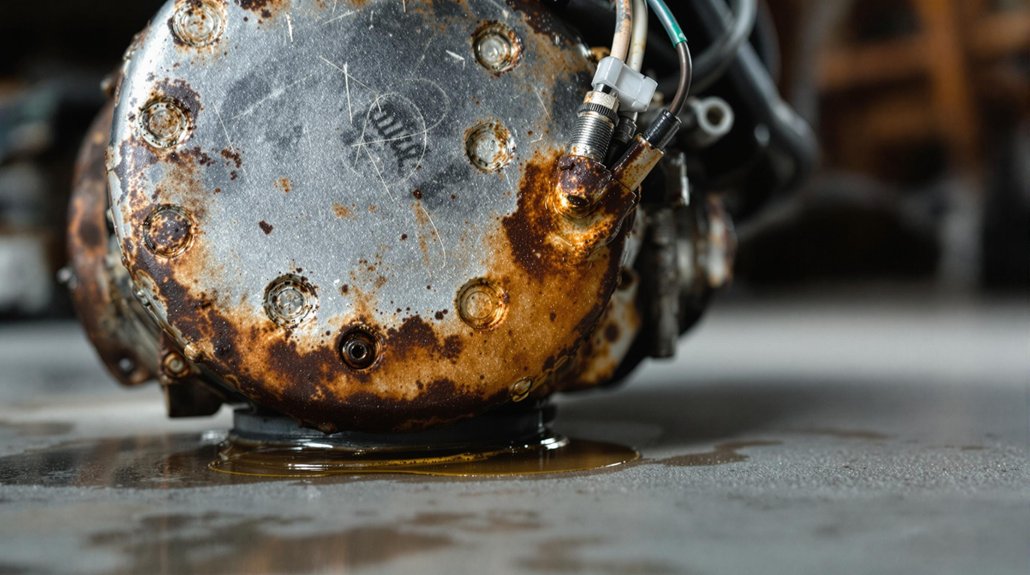
Visible wear and tear can indicate problems with your garage door motor. Look for signs such as rust or corrosion, loose or damaged parts, and unusual noise patterns. Addressing these issues early can help prevent further damage and guarantee safe operation.
Rust or Corrosion
Rust and corrosion are common indicators of wear and tear on a garage door motor. These issues can greatly affect the motor's performance and lifespan. When moisture enters the motor housing, it can lead to rust formation on metal parts. This rust can weaken components, making them less effective or causing them to fail entirely.
To address rust, regular maintenance is crucial. Start with rust prevention methods, such as applying protective coatings to metal surfaces. These coatings can create a barrier against moisture and limit rust formation. If rust is already present, it is essential to employ corrosion treatment. This often involves cleaning the affected areas with a wire brush and applying rust remover solutions. Once the rust is treated, consider repainting the surface with a rust-resistant paint to prevent future issues.
Loose or Damaged Parts
A garage door motor relies on various components to operate smoothly, and any loose or damaged parts can greatly hinder its performance. It is essential to inspect the motor regularly for visible wear and tear. Loose screws can cause instability in the motor, leading to improper function. Damaged gears can also prevent the motor from working effectively.
Identifying these issues early can save you from costly repairs or replacements. Here is a simple table to help you recognize the signs of loose or damaged parts:
| Component | Symptoms | Action Needed |
|---|---|---|
| Loose Screws | Unstable motor movement | Tighten screws |
| Damaged Gears | Jerky or slow operation | Replace gears |
| Worn Springs | Uneven door movement | Inspect and replace |
| Broken Brackets | Visible cracks or breaks | Replace brackets |
| Loose Chains | Slipping or noise | Tighten or replace |
Unusual Noise Patterns
When operating a garage door, any unusual noise patterns can indicate underlying issues with the motor. Common sounds to watch for include grinding, squeaking, or banging. These noises often signal that the motor is struggling or that parts are worn. Proper garage door maintenance is key to identifying these issues early. Regularly check the motor and its components for signs of wear.
If you hear grinding noises, it may mean the motor gears are damaged. Squeaking sounds might indicate that the rollers or tracks need lubrication. Banging noises can suggest loose parts that require tightening. Ignoring these sounds can lead to more significant problems and even complete motor failure.
If you notice any unusual noise patterns, it is essential to assess the situation promptly. Follow motor replacement tips if repairs are not possible. This includes turning off the power to the garage door and consulting a professional if you are unsure how to proceed. Remember, addressing these issues early can save you time and money by preventing more extensive damage later.
Excessive Vibrations
Excessive vibrations from a garage door motor can indicate underlying issues that require immediate attention. These vibrations may arise from several vibration causes, such as loose hardware, misaligned tracks, or worn-out components. When the motor struggles to operate smoothly, it can create unnecessary stress on the entire system.
To effectively address excessive vibrations, it is crucial to first identify the root cause. Start by inspecting the garage door for any loose bolts or screws. Tightening these parts can often reduce vibrations considerably. Next, check the alignment of the tracks. If they are bent or misaligned, this can lead to increased vibration. Adjusting the tracks back into position may provide a quick vibration solution.
Additionally, examine the rollers and hinges for wear and tear. If they appear damaged or rusty, replacing them can improve the motor's performance and lessen vibrations. In some cases, the motor itself may be the source of the problem. If the motor is old or damaged, it may need to be repaired or replaced. Addressing these issues promptly will guarantee that your garage door operates smoothly and safely.
Motor Overheating
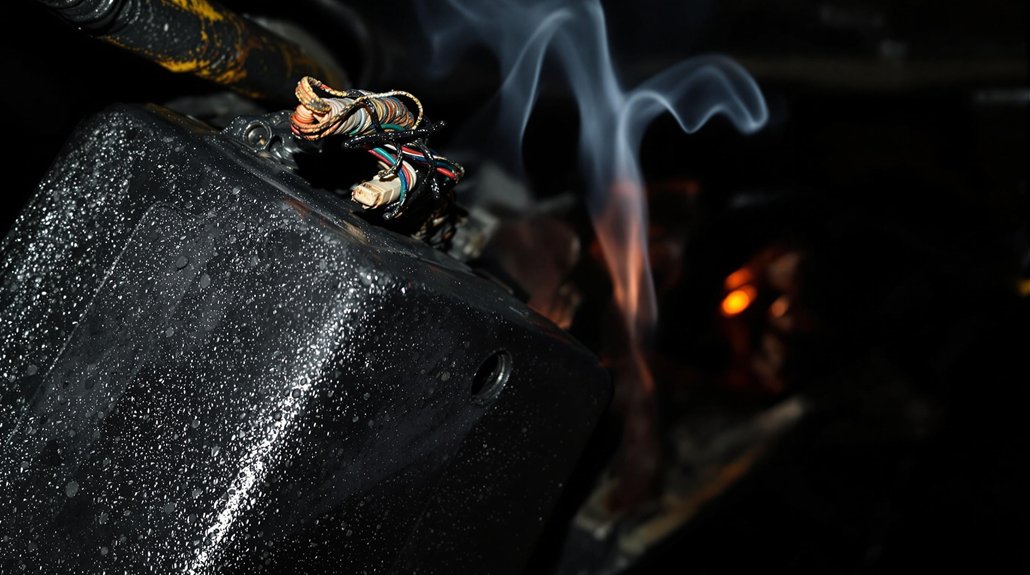
Motor overheating is a serious concern that can arise from various factors, often linked to the overall health of the garage door system. When the motor overheats, it can lead to failure if not addressed promptly. Several reasons can contribute to this issue.
- Inadequate Motor Cooling: If the motor's cooling system is not functioning properly, it can cause excessive heat buildup. Dust and debris can obstruct airflow, reducing cooling efficiency.
- Faulty Thermal Sensors: These sensors detect temperature changes and help maintain safe operating levels. If they malfunction, they may not signal the motor to cool down, resulting in overheating.
- Overuse or Strain: Continuous operation or heavy loads can put extra strain on the motor, causing it to overheat. Regularly checking the load capacity can prevent this.
Monitoring these factors is crucial for maintaining a healthy garage door motor. Regular maintenance and inspections can help guarantee that the motor cooling system works effectively and that thermal sensors are functioning correctly. By addressing these concerns early, you can prolong the life of your garage door motor and avoid costly repairs.
Warning Lights Indicators
Warning lights on a garage door motor serve as essential indicators of potential issues that may affect its performance. Different warning light types can signal various problems. For example, a steady red light may indicate that the motor is not receiving power, while a flashing yellow light can suggest an obstruction in the door's path. Recognizing these signals is crucial for effective troubleshooting.
To troubleshoot, first check the power source. Verify that the motor is plugged in and that the circuit breaker is not tripped. If the warning light remains on, inspect the sensors for dirt or misalignment. Clean the sensors gently and adjust their position if needed.
In some cases, a blinking light may point to a problem with the remote control or keypad. Change the batteries and reprogram the device to see if the issue resolves. If none of these troubleshooting tips work, it may be time to consult a professional for further assistance. Understanding warning light types and their meanings can help you maintain your garage door motor and prevent costly repairs in the future.
Age of the Garage Door Motor
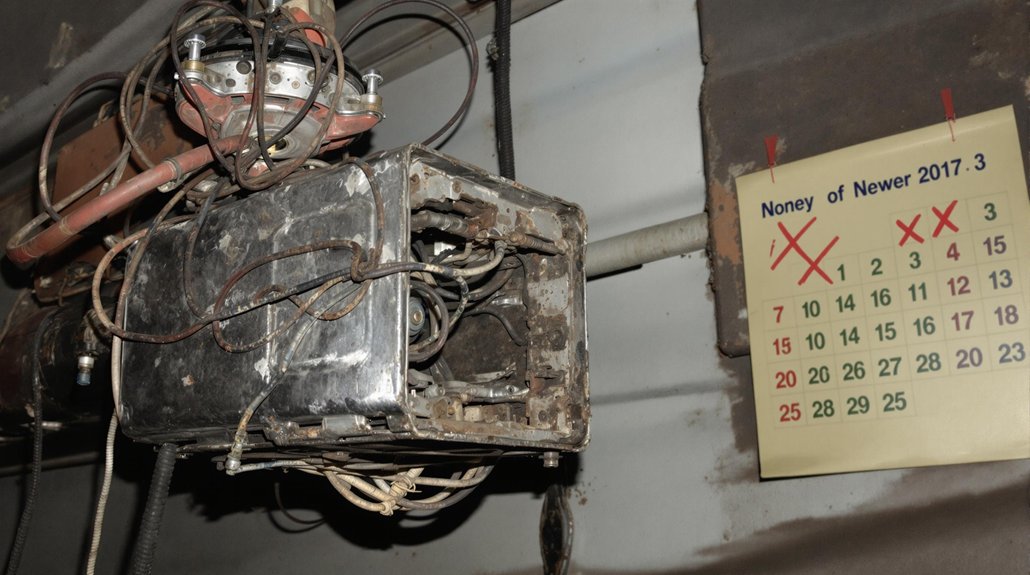
The lifespan of a garage door motor plays a significant role in its overall performance and reliability. Typically, a garage door motor can last between 10 to 15 years, depending on usage and maintenance. As the motor ages, it may show signs of decline, which could indicate the need for replacement.
To assess the age and condition of your garage door motor, contemplate these three factors:
- Frequency of Use: Motors that operate multiple times a day may wear out faster than those used less frequently.
- Maintenance History: Regular maintenance can extend the motor lifespan. Neglecting maintenance can lead to premature failure.
- Signs of Wear: Listen for unusual noises or observe if the door struggles to open or close. These could be early warning signs of a failing motor.
Implementing proper maintenance tips, such as lubricating moving parts and checking connections, can prolong the motor's life. If your garage door motor is nearing the end of its lifespan, it's wise to contemplate a replacement before complete failure occurs, ensuring safety and functionality in your home.
Frequently Asked Questions
How Long Does a Typical Garage Door Motor Last?
Like a reliable car engine, a typical garage door motor lasts about 10 to 15 years. Regular maintenance can extend garage door lifespan, while timely motor replacement guarantees continued functionality and safety for your home.
Can I Repair a Bad Garage Door Motor Myself?
Yes, you can attempt DIY repairs on a garage door motor. Start with basic motor troubleshooting to identify the issue. However, make certain you have the necessary tools and knowledge to avoid potential safety hazards.
What Brands Are Known for Reliable Garage Door Motors?
Reliable garage door motor brands include Chamberlain, known for positive reviews, and LiftMaster, praised for its robust features. Both brands offer dependable performance, ensuring security and convenience for homeowners seeking quality garage door solutions.
How Often Should I Maintain My Garage Door Motor?
Like a well-tuned clock, a garage door motor requires regular care. Establish a maintenance schedule that includes motor lubrication every six months to guarantee peak performance and longevity of your garage door system.
What Are the Signs of a Failing Garage Door System?
Signs of a failing garage door system include sudden noises during operation and a slow response when opening or closing. These issues often indicate underlying problems that may require immediate attention to guarantee safe and effective functionality.
